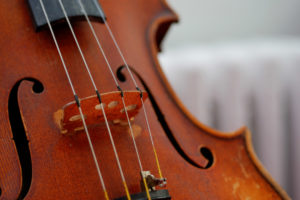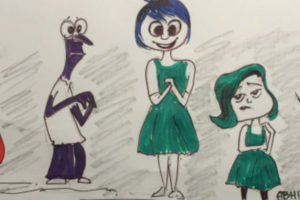Angela Richardson sits at the head of the table, a colorful array of art supplies – paper, colored pencils, markers, scissors –scattered in front of her. Richardson is this year’s Artist in Residence at the Center for Healthy Minds as part of a larger effort to understand different avenues to increase well-being.
“I want you to flip open to a clean page in your notebook and draw four quadrants,” she says. Everyone complies. For the next five minutes, Richardson instructs participants to fill out the quadrants with what they have done, seen and heard in the last 24 hours. The fourth and final quadrant is reserved for a drawing of something – positive or negative – that has deeply affected the person.
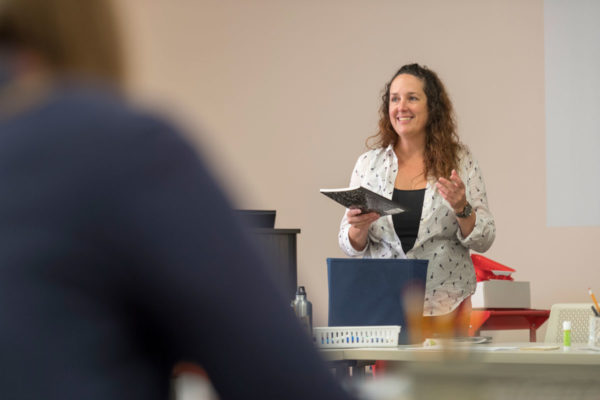
On the first day of Drawing Gym, Artist-in-Residence Angela Richardson discusses the power of composition notebooks for creativity and exploration.
Bringing inner experiences outward into art is, in a sense, an exercise in mindfulness – to call attention to the mundane, joyful, exceptional and even the troubling that we witness in our daily lives.
Richardson leads such practices weekly at the Center as part of “Drawing Gym,” a contemplative arts class open to all staff and scientists. By experiencing the contemplative arts firsthand, the program seeks to spark ideas among researchers about how to integrate the arts into their work and concepts of human flourishing.
Across all Drawing Gyms the message is the same: This is a judgement-free space in which people are allowed to try new things, make mistakes and play.
“Allowing yourself to play is a practice. It’s about engaging with the parts of yourself that are good at entertaining the outlandish, the silly and the strange. Drawing Gym allows interruption in the sense of urgency to ‘get things done,’ ” says Richardson. “It’s a momentary shift that can be carried forward into the rest of the workday. Perhaps it allows a different point of view as someone is problem-solving or engaging another part of their creativity or their brain. Going back to that idea of discovery, artistic, generative play helps us remember that we’re on an adventure, even as we work.”
“Allowing yourself to play is a practice. It’s about engaging with the parts of yourself that are good at entertaining the outlandish, the silly and the strange.”
The contemplative arts, like other interventions the Center explores, could yield new ways to improve well-being in people of all ages and backgrounds.
For instance, previous research suggests that incorporating the arts into the fabric of our daily lives – from work and school to therapy and relaxation time – improves overall well-being across age groups.
Young adults who engaged in a creative activity reported increased positive emotion and flourishing. Veterans who received writing exposure therapy showed improvements similar to traditional trauma treatment. In addition, the journaling treatment was just as effective in a considerably shorter time frame.
Other examples include studies with aging adults who participated in a theater group who subsequently showed better memory recall. When teachers reinforce academic concepts with the arts – painting, writing, singing, drawing, sculpting – it can improve children’s retention and learning. Even simply adding artwork and plants to a workspace can increase employees' productivity.
For Richardson, the contemplative arts are rooted in working with our hands and practicing paying attention. No two Drawing Gyms are the same.
One week the theme was “Darkness.” Participants painted on creamy white paper with thick, black ink. The following week, Richardson chose “Light” as the theme and participants dabbled in water color. Each theme represented an opportunity for participants to explore lightness and darkness in their lives and within themselves, whether it be their own emotions or events in their lives.
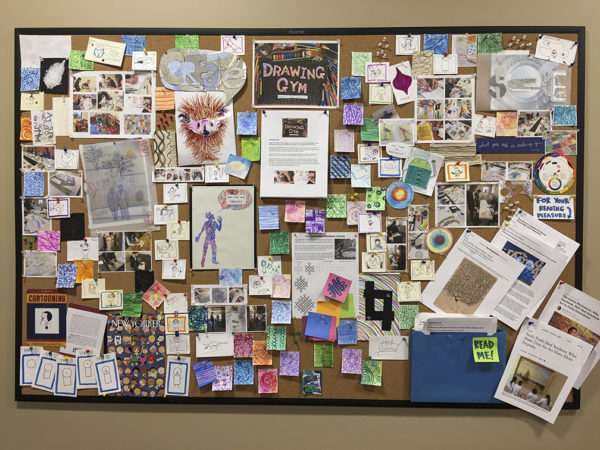
As part of the Drawing Gyms, Richardson collected artwork and displayed it for employees at the Center to admire.
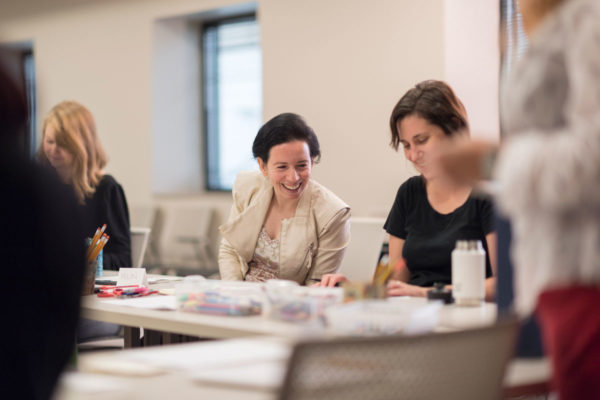
Pelin Kesebir, one of the lead scientists on the project, enjoys her time in Drawing Gym.
It’s this possibility of discovery and adventure that drives researchers from the Center to explore well-being in new and ground-breaking ways that go beyond meditation and mindfulness.
After all, there is no single prescription for happiness and well-being.
“It’s important for people to know that the Center is not just a mindfulness shop. A lot of people are interested in exploring ways to cultivate well-being in a broad sense,” says Robin Goldman, Director of the Research Support Core at the Center as well as a scientific lead exploring the potential of the arts. “It’s not just about sitting on a cushion. The goal is to increase people’s well-being, not that it should only be done in a specific way. To use a physical health analogy, there are multiple ways to improve cardiovascular health, like running, biking, swimming and playing sports. These all cultivate cardiovascular health but are different paths to it. The same holds true for psychological well-being.”
Supported by the generosity of Claudia Madrazo and Roberto Hernandez and the Contemplative Art Fund, the Center has been experimenting with the arts over the past two years, starting with a collaboration with the Academy for the Love of Learning in Santa Fe, New Mexico. Over the course of a year, Center staff and scientists participated in five, day-long workshops aimed at teaching them how to learn through creative, unconventional means. The Academy believes that at its best, learning is both informative and transformative and ultimately is a practice that can awaken our hearts and enable us to become more fully and compassionately human.
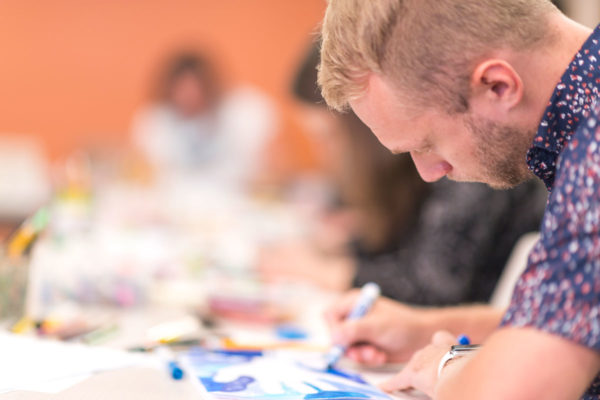
Center staff member Jon Hess focuses on coloring in shades of blue at a Drawing Gym.
Center experts are still exploring how the contemplative arts can be integrated more into research. At a recent meeting on the topic distinct patterns emerged. Some people noted an initial discomfort participating in Drawing Gym because making art has been deemed less valuable than other types of work. One person mused, “Drawing Gym is fun. Is it OK to have fun at work?”
Yet beyond having fun, Drawing Gym has positively affected Center staff.
Nate Vack, a software developer at the Center, reports that a drawing exercise in which participants suspended judgment about their work helped him quiet his internal critic once he was back at his desk.
“I had an idea of creating something recently. I was thinking it would take a lot of time and it would have to be perfect,” Vack says, “But then I asked myself, ‘What if it didn’t have to be perfect?’ and moved forward creating something in a few hours. It wasn’t perfect, but I proved a concept and moved on.”
Other people echoed Vack’s sentiment, noting that they make art in Drawing Gym free of judgment or critique. Another person noted that Drawing Gym allows her to create without thinking, but rather by doing.
When it comes to the relationship between the arts and well-being, there are more questions than answers, and that’s part of the process, says Goldman.
At the same time, people noticed how they connected with their emotions during Drawing Gym in an unconventional way. Rather than simply thinking about feelings, participants notice that the art they create tends to reflect their mental state – as if the canvas itself was a messenger for a person’s internal life.
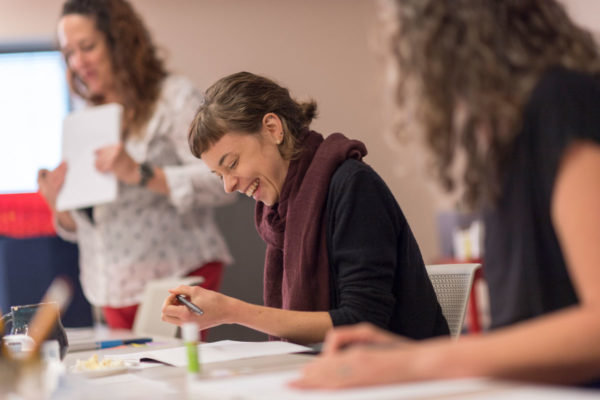
Stephani Pescitelli, a Center for Healthy Minds staff member, laughs as she draws.
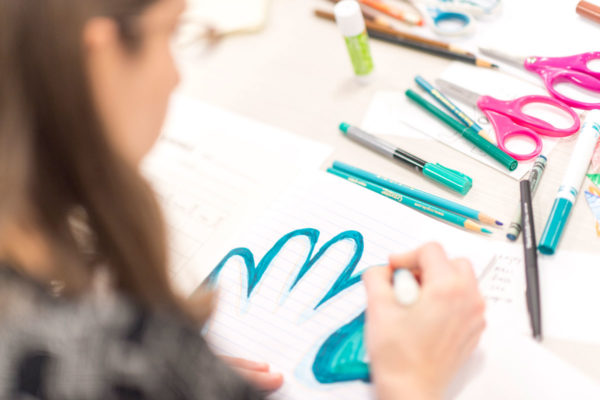
A participant traces the outline of her hand in shades of turquoise and teal.
Something about Drawing Gym, it seems, is working as Angela Richardson intends.
She hopes that new research can demonstrate the overwhelming importance of the arts for the brain, providing teachers, therapists, and policy-makers with evidence for supporting the arts.
“You can retrain your brain. If you get stuck in a groove, it’s not the end of the story. You can train yourself to think differently,” Richardson says. “I think that using art is just another method and set of tools for retraining the brain. It allows us to let go of habits that are not serving us and instead, cultivate ones that do.”
-Brita Larson


